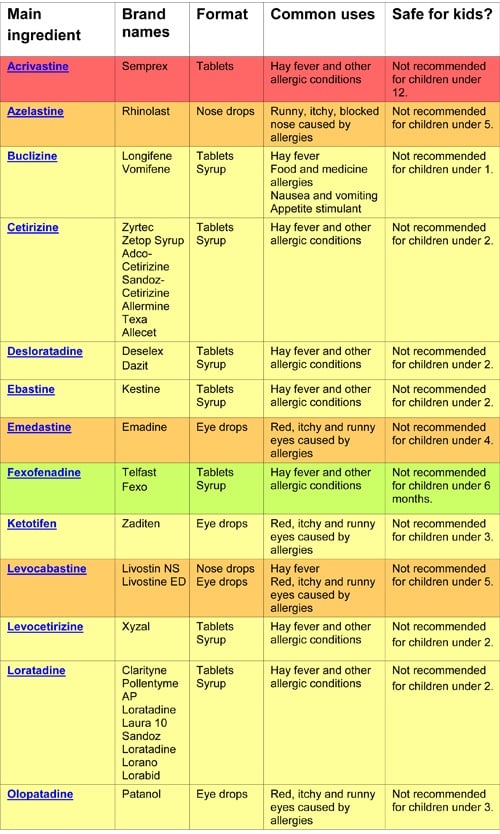Earlier this year, we published a story about how certain allergy medication can react negatively with your child, even causing aggression, hyperactivity or anxiety. We had a few concerned parents asking us which antihistamines are more likely to affect their children's behaviour, so we decided to break it down.
Read more: Effects of allergy medication on your child's behaviour
What are antihistamines?
Antihistamines are medicines used to treat allergy symptoms such as hay fever, itchy eyes, hives, stings and rashes, and allergic reactions to food. It can also relieve itching caused by chicken pox, eczema and insect bites. Many antihistamines are available over the counter as tablets, syrups, nasal sprays, eye drops or ointments. Several brands have paediatric versions, which are syrups specifically aimed at (and supposedly safe for) children.
Antihistamines aren't only used for allergies, however. Some are more commonly used to treat nausea and vomiting, such as Cyclizine (the main ingredient in Valoid), while others are prescribed to patients battling with insomnia, or as an appetite stimulant. In fact, the first antipsychotic medicine was actually an antihistamine!
In this article, we will focus on antihistamines used for allergies.
Types of antihistamines
Antihistamines are divided into two groups, namely first-generation and new- or second-generation.
First-generation antihistamines
The first antihistamines are also known as sedatives, and for good reason. These drugs may relieve your allergy symptoms very quickly, but they are almost guaranteed to make you very drowsy – so much so that they are also used to treat insomnia!
First-generation antihistamines affect the central nervous stem, which can also lead to irritability and mood swings, anxiety, slow thinking and slow learning, especially in children. And, contrary to their sedative nature, they could lead to insomnia and hyperactivity. Other side-effects include dry mouth, dry cough, constipation, diarrhoea and trouble urinating.
On top of that, their anti-allergic effects don't last very long, so you have to take a new dose every 4 to 6 hours.
But because they are cheap, easily available and fast-acting, first-generation antihistamines remain popular. Brand names include Allergex, Polaramine and Benadryl.
Disclaimer: This table is for information purposes only. Please consult your doctor and read the inserts carefully before administering any of these medicines to children.

Colour-code:
- The green rows are safe for babies over 6 months
- Yellow means generally safe for children over 2 or 3.
- Orange indicates the meds aren't suitable for children under 6.
- Red is not suitable for kids under 12, and in the case of promethasz
New-generation antihistamines
New- or second-generation antihistamines were developed to decrease the negative side-effects of their first-generation forerunners. They are meant to be non-sedative (or at least less so), and they last long enough that you only have to take one or two doses per day. Popular brands include Allecet, Zyrtec and Clarityne.
Some doctors and pharmacists may also talk about "third-generation" antihistamines. These refer to medicines containing levocetirizine, desloratadine or fexofenadine, and they're supposedly more effective and have even fewer side-effects than other new-generation ingredients. Examples are Deselex, Telfast and Xyzal.

Are antihistamines safe for children?
Allergies, especially hay fever, are very common among young ones, and so antihistamines are some of the most commonly prescribed medicines for children. But not all of these are safe for kids, and very few are safe for babies.
Read more: Over-the-counter medicines for baby
Because of their negative side effects, first-generation antihistamines should be used with great caution in children. According to this paper, the effects of these meds on children have never really been studied properly, so it's probably safer to steer clear – even if it is offered as a paediatric syrup. One first-generation drug, Promethazine, has even been linked to SIDS.
New-generation antihistamines have been subjected to stricter studies and rules, and so their effects on children are better known. However, even these drugs can have side effects, including the drowsiness that they're meant to exclude.
Because they work in central nervous system (and brain chemistry), and everyone is wired differently, different antihistamines may be effective for different children, and side effects can vary widely, depending on the child.
The bottom line? Like with all over-the-counter medicines, you should speak to your doctor before treating your child's allergies with antihistamines. A doctor can help you choose the right antihistamine, give your child the correct dosage and monitor any possible side effects.
And if your child reacts negatively to one, ask your doctor for an antihistamine with a different active ingredient.
Sources: http://sapajournal.co.za/index.php/SAPA/article/viewFile/104/97, ftp://hst.org.za/pubs/samf/R06HTML.HTM, http://www.jiaci.org/issues/vol17s2/5.pdf
Which antihistamines have been prescribed for your child, and have they experienced such negative side effects that you had to stop or change to a different antihistamine? Send your comments to chatback@parent24.com.




 Publications
Publications
 Partners
Partners














